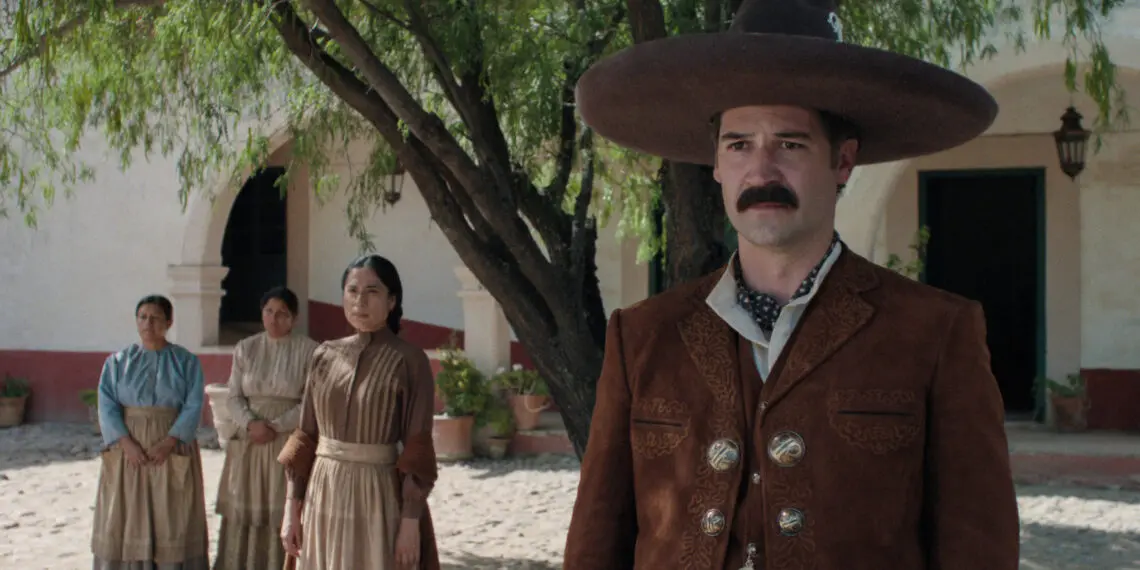A surreal journey through time: Rodrigo Prieto’s ‘Pedro Páramo’
Magical realism meets epic family drama
In the magical realist world of “Pedro Páramo,” Rodrigo Prieto makes his directorial debut with a visually arresting adaptation of one of Mexico’s most influential novels. Known for his exceptional work behind the camera on films like “Barbie”, “Killers of the Flower Moon”, and “Brokeback Mountain”, Prieto brings a keen eye to Juan Rulfo’s 1955 masterpiece. This melancholic tale, rendered beautifully through meticulous cinematography, single-handedly translates Rulfo’s ghosts and memories into a grand, if slightly imbalanced, family saga.
Duel of legends: Huerta and García Rulfo bring depth to their roles
Tenoch Huerta, recognized for his role in “Black Panther: Wakanda Forever,” stars as Juan Preciado, a man who journeys to the eerie town of Comala to uncover his father’s secrets. Instantly, he discovers that his father, the storied Pedro Páramo played by Manuel García Rulfo, has already passed. The town, filled with spectral remnants of its past, presents more questions than answers, guiding Juan through a maze of candlelit tales and ghostly encounters.
A town suspended in time
Set during the post-Revolution period (1910-20), Comala is a silent, enigmatic place rendered with stunning detail. Cobbled streets and abandoned homes become the staging ground for supernatural exchanges, blurring the lines between the living and the dead. The careful balance and interplay of light and shadow create a visual spectacle, marking it as a hallmark of Prieto’s keen cinematographic sense.
Transitioning eras with seamless precision
The screenplay, penned by Mateo Gil, captures the essence of Rulfo’s seminal work by faithfully following its non-linear narrative. The film transitions fluidly between the late 19th and early 20th century, symbolizing the layers of time unfolding within the same frame. The camera movement between different rooms and periods is masterfully executed, bringing Comala’s deserted alleys to life with bursts of vibrant color amidst bleakness.
A tale of love, power, and tragedy
Pedro Páramo’s story, teeming with Shakespearean echoes, weaves a complex web of power, ambition, and fleeting love. As a charismatic yet ruthless figure, Pedro commands the town and its people with unwavering authority. His life is marked by tempestuous relationships, including one with Juan’s mother, Dolores (Ishbel Bautista). However, his heart truly belongs to Susana (Ilse Salas), a love he yearns to rekindle.
Gustavo Santaolalla’s powerful score resonates deeply, encapsulating Pedro’s unending longing for Susana, adding an emotional heft to the narrative. Tragedy permeates Pedro’s existence, with cosmic justice lurking at every turn, leaving the audience to ponder whether Pedro’s grief is well-deserved.
Complex narrative and innovative structures
Prieto demonstrates his story-telling prowess through intricate narrative switches and meticulously crafted scenes. Juan’s journey is marked by unsolicited visions of the past, bringing Pedro’s life and downfall into sharp focus. The film’s back-and-forth structure embraces the traditions of magical realism, reminiscent of Rulfo’s original novel.
A haunting visual experience
Prieto’s dual role as director and cinematographer lends the film an enigmatic charm. His collaboration with Nico Aguilar in handling the director of photography duties helps create a visual narrative that is both disconcerting and immersive. The first half of the movie teems with surreal happenings and disjointed sound designs, which subtly unsettle the audience.
Shifting from surrealism to operatic drama
Despite its engrossing premise, “Pedro Páramo” transitions into a more classical storytelling mode in its latter half, focusing intently on the darker aspects of Pedro’s life. This shift, while impactful, leads to the film losing some of its initial dreamlike quality. Nevertheless, the operatic performances by the cast and Prieto’s deft handling of the film’s emotional core ensure that the narrative remains compelling.
The tapestry of greed, love, and self-destruction that Pedro navigates is brought to life with poignant visual artistry. Though the film grapples with its pacing and structure, the underlying tragic longing echoes powerfully throughout its runtime.
Experience the haunting beauty of “Pedro Páramo” – a masterclass in visual storytelling, blending magical realism with an exploration of human emotions and cosmic justice. Join the conversation about this captivating film on social media and stay tuned for more expert insights and reviews.

 Italian
Italian







